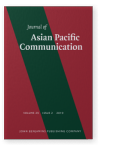Vol. 29:2 (2019) ► pp.149–167
White cyber-protest in a Facebook group
Articulating colorblind racialization in response to perceived South Korean televised “xenophobia”
This study builds upon a nascent body of scholarship that examines the transnational movement of White Westerners. The purpose is to complicate the literature on multiculturalism and globalization by examining the “reverse” migration from, rather than to, the West. Specifically, it examines White migrants’ mobilization of online social protest through a Facebook group that came together in response to a report broadcast on South Korea’s Munhwa Broadcasting Company (MBC) that was interpreted as racist and xenophobic. In response, White residents in Korea organized dissent and engaged in symbolic protest that served a collective ego function, creating community around a perceived sense of shared oppression as racialized minorities. To do so, they drew on global hierarchies, White supremacy, and heteronormativity to challenge their lack of control over their own representations in the local culture.
Article outline
- Methodological decisions
- Blogging, social networking sites, & race
- Igniting protest
- Colorblind racialization and self
- Symbolic resistance
- Direct address
- Sarcasm
- Conclusion
- Acknowledgements
- Notes
-
References
